
Roots
There exists, within the very coil and curve of a strand, a silent archive. For generations of Black and mixed-race people, our hair has been more than a physiological outgrowth; it stands as a living document, a testament to endurance, innovation, and an unbroken lineage of communal wisdom. We speak of cornrows not as a mere coiffure, but as a language spoken through deft hands, a calligraphy of the scalp that charts courses across forgotten histories and into vibrant, defiant presents.
This intricate braiding technique, with its ordered precision and deep cultural resonance, reaches back through millennia, connecting us intimately to the soil of ancient lands and the ingenuity of our forebears. Each parallel ridge, each deliberate parting, carries the echoes of survival, coded messages whispered from one generation to the next, often under the very gaze of oppression.

Anatomy of a Story Braided In
To truly grasp the significance of cornrows, particularly their role in historical acts of resistance, we must first recognize the extraordinary nature of textured hair itself. The helix of a melanin-rich strand presents unique biological characteristics ❉ its elliptical cross-section, its tendency to coil and kink, and the distribution of its disulfide bonds. These structural attributes, a marvel of natural engineering, lend themselves to the very resilience and versatility seen in cornrows. Unlike straight hair, which hangs freely, textured hair’s propensity for entanglement, when expertly manipulated, creates a secure, lasting foundation for braided styles.
This inherent biological quality, honed and understood over countless centuries, informed the earliest styling practices. Our ancestors, acutely attuned to the properties of their hair, developed methods that worked with its natural inclinations, long before the advent of modern trichology. They understood, with an intuitive brilliance, how to protect, preserve, and sculpt these wondrous strands.
Cornrows are not merely a hairstyle; they represent an ancient language, meticulously braided onto the scalp, speaking volumes of cultural identity and unwavering resilience.
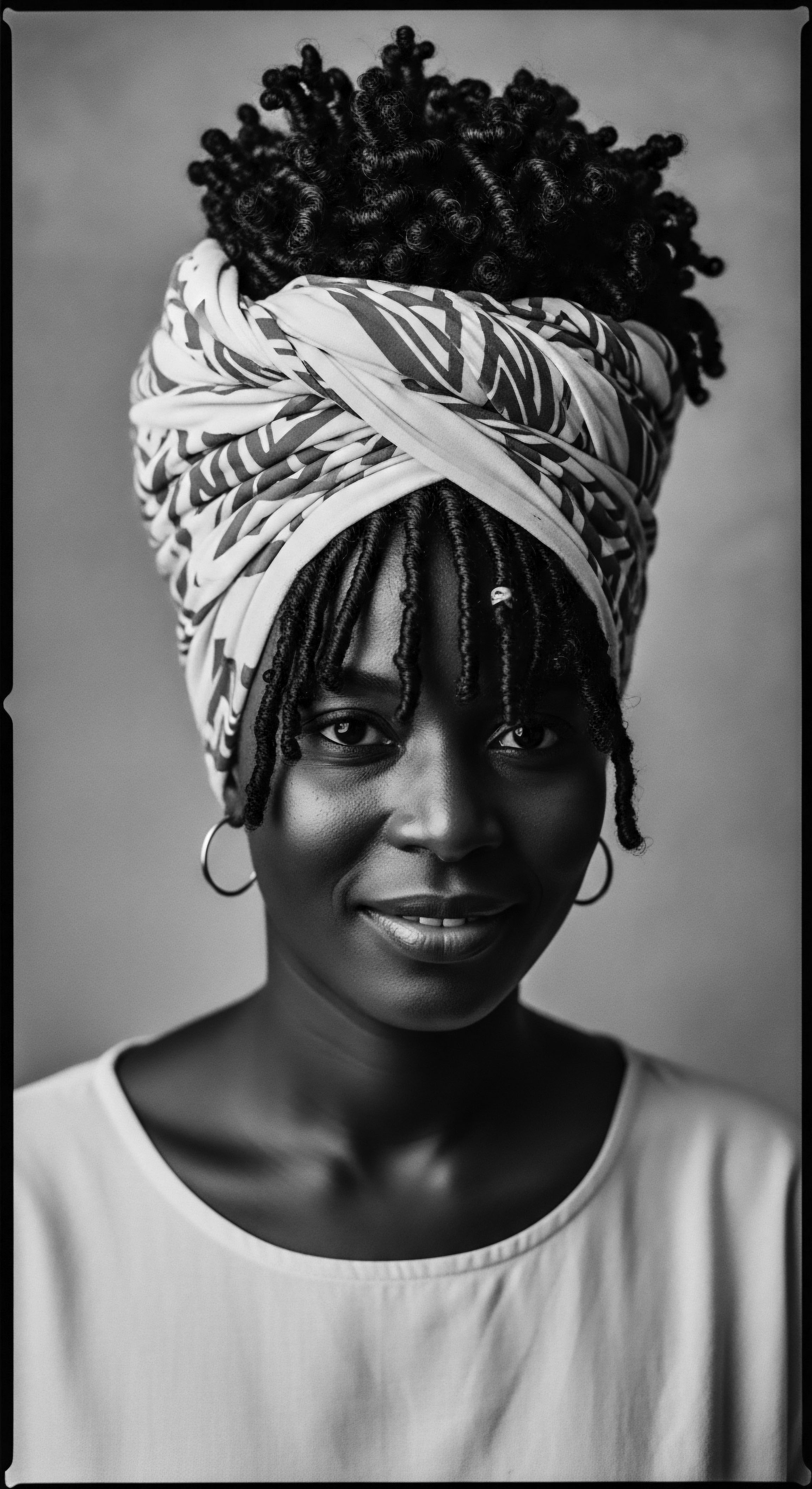
Ancestral Wisdom and Hair’s Materiality
The practice of styling hair, particularly in ways that involved braiding and intricate patterning, predates recorded history in many African societies. Archaeological evidence and oral traditions point to a sophisticated understanding of hair care and manipulation. For instance, in West Africa, the practice of braiding, including what we recognize as cornrows, was deeply interwoven with social status, spiritual beliefs, and tribal identity. The specific patterns could denote marital status, age, community affiliation, or even a person’s readiness for war.
Such practices underscore a profound connection to the body as a vessel for cultural expression and communal bonding. The very materials used, from natural oils pressed from indigenous plants to pigments derived from earth minerals, reflect a deep engagement with the local environment, a holistic approach to wellbeing that saw hair as a living extension of self and community. These methods were not random acts of beautification; they were rituals, passed down, each motion carrying meaning, each braid a link in an unbroken chain of Ancestral Knowledge.
Consider the term “cornrows” itself, a descriptor born from the striking resemblance these braids bear to rows of corn in a cultivated field. This term, while descriptive, often obscures the multitude of indigenous names and cultural significances that existed across various African ethnic groups. For example, in parts of Nigeria, certain cornrow patterns might be referred to by names that denote specific tribal markings or historical events. This naming convention highlights how deeply hair patterning was integrated into the daily and ceremonial life of communities.
The very act of braiding often became a communal event, solidifying intergenerational bonds as elders taught younger members, sharing stories, history, and life lessons, alongside the technical skill of braiding. The hair, therefore, became a medium for transmitting Cultural Heritage.
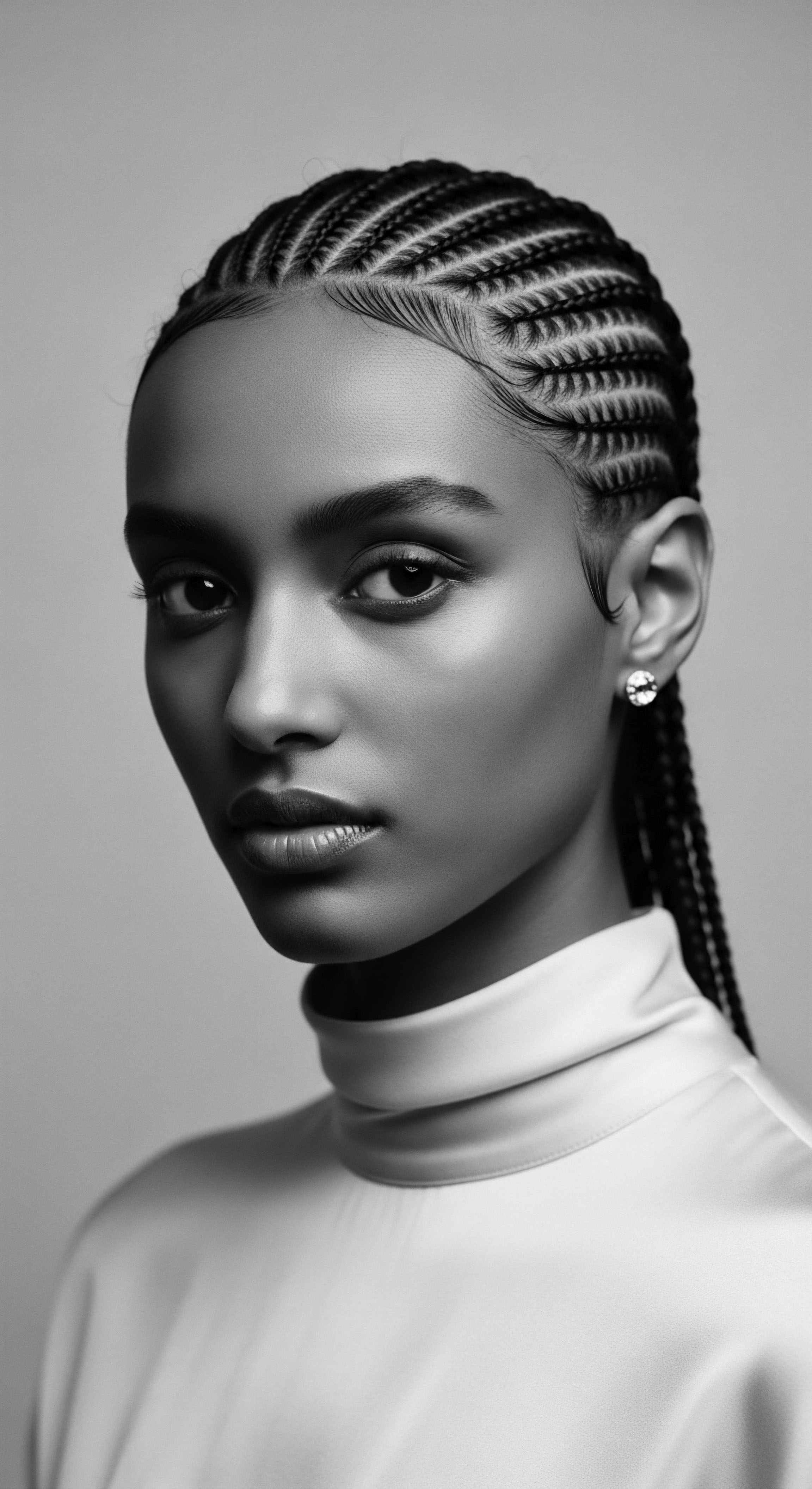
Echoes of Early Systems
The classification of textured hair today often uses systems like the Andre Walker Type System (1990s), which categorizes hair by curl pattern (1A to 4C). While offering a useful modern lexicon, it is vital to acknowledge that such systems are relatively new. Our ancestors had their own nuanced understandings, often tied to function, spiritual significance, and social roles rather than just curl type.
They recognized that a particular braid pattern would protect hair during long journeys, or allow for easy concealment of valuable items, or mark a person as free or enslaved. These practical classifications, deeply intertwined with survival and identity, formed their own lexicon, often unspoken, conveyed through practice and observation.
| Aspect of Hair Structure and Function |
| Pre-Colonial African Understandings Understood hair's protective qualities, its ability to retain moisture when braided, and its adaptability for various functions (e.g. carrying seeds). This knowledge was practical, empirical, and communal. |
| Aspect of Hair Classification |
| Pre-Colonial African Understandings Based on social markers, spiritual significance, tribal affiliation, and practical utility. Patterns were mnemonic devices or status symbols. |
| Aspect of Hair Care Rituals |
| Pre-Colonial African Understandings Holistic; intertwined with medicinal plants, community rituals, and rites of passage. Hair care was a collective endeavor, reinforcing kinship and heritage. |
| Aspect of Hair The deep historical knowledge of hair's utility and symbolic power underpins its enduring significance in Black identity. |
The very act of forming a cornrow requires a deep understanding of the hair strand’s resilience. The uniform tension, the meticulous sectioning, the constant pulling and twisting of the hair close to the scalp, all demonstrate an intuitive grasp of the hair follicle’s strength and the hair shaft’s capacity to be manipulated without undue stress. This ancient engineering, perfected over generations, allowed for styles that could last for weeks, protecting the hair from environmental elements and minimizing breakage. This foundational knowledge, born from observation and necessity, constitutes a significant part of our textured hair heritage, a testament to the scientific acumen present in ancestral practices long before the term “science” was formalized in Western thought.
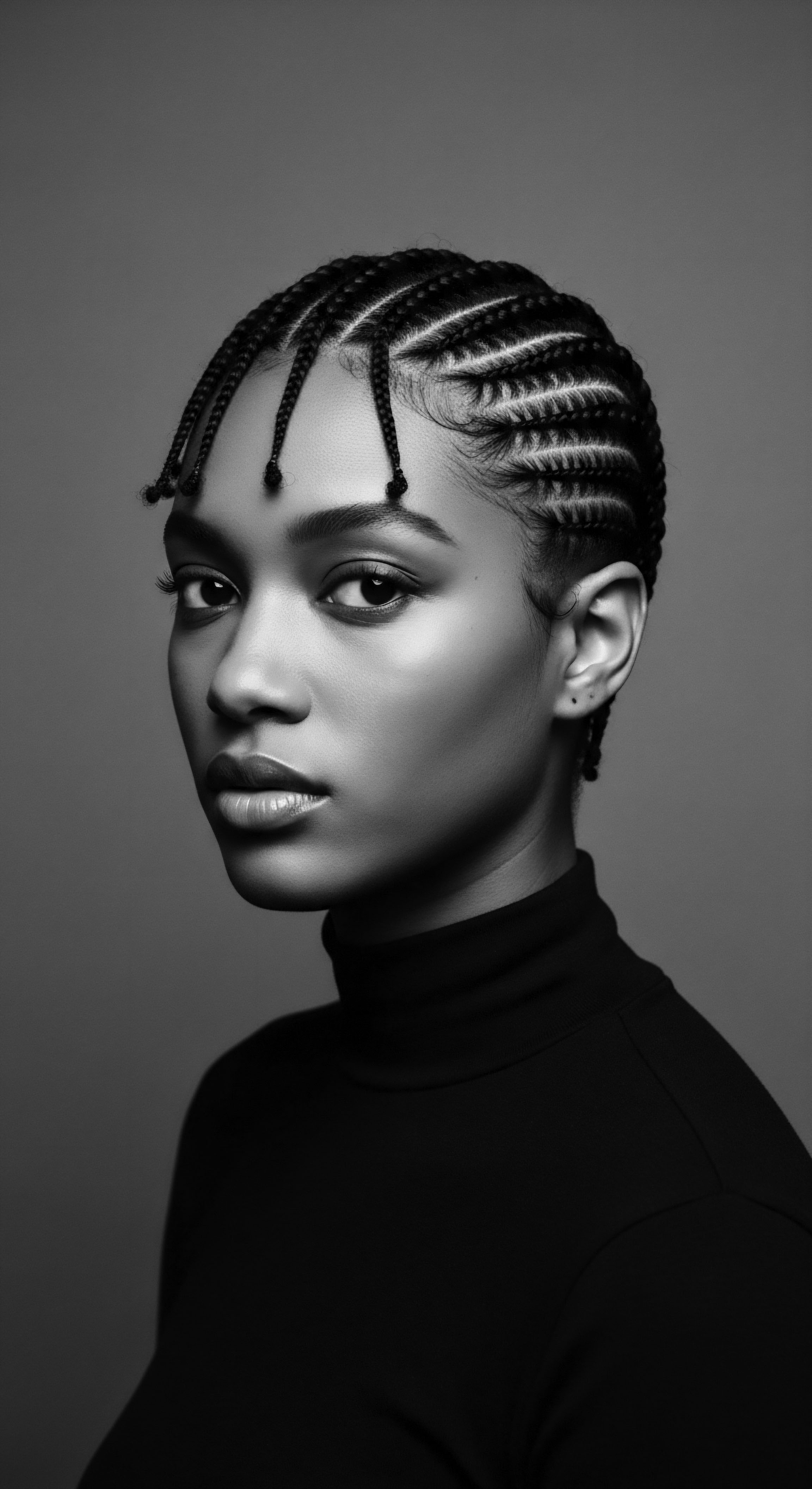
Ritual
The journey of cornrows from their ancient African origins to their role in modern Black identity is a story of adaptation, defiance, and profound cultural continuity. As African people were forcibly displaced across the Atlantic, stripped of their material possessions and often their very names, their hair remained an indelible connection to home, to lineage. Cornrows, resilient and versatile, became more than just a means of managing hair in harsh conditions; they transformed into living canvases of resistance, silent shouts in the face of dehumanization.
These deeply personal and publicly visible statements carried an entire heritage within their careful arrangement, speaking when voices were silenced, acting as maps when freedom seemed an impossible distant star. This transformation speaks to the innate human spirit’s capacity to find agency and meaning even in the most oppressive circumstances.

How Did Cornrows Become Instruments of Covert Communication?
During the transatlantic slave trade, when millions were torn from their homes and traditions, the act of hair shaving was a deliberate tactic to strip enslaved Africans of their identity and culture. Yet, despite these brutal attempts at erasure, hair braiding persisted as a profound act of cultural resistance. In the Americas, particularly in regions of South America like Colombia, oral histories recount how cornrows were utilized to convey secret messages and even escape routes for those seeking liberation. Ziomara Asprilla Garcia, an Afro-Colombian hair braider and oral historian, relates how women would braid specific styles to signal their intent to escape.
One such style, called Departes, featured thick, tight braids close to the scalp, tied into buns on the top, signaling plans to depart. Other styles, with curved braids, represented the winding roads and paths escapees would follow.
The ingenuity extended beyond mapping. Within the very strands of the cornrows, enslaved individuals would conceal tiny gold nuggets or seeds, provisions for their perilous journeys to freedom. These seeds were not only for sustenance during escape but were also planned to be planted in liberated settlements, symbolizing a tangible link to future self-sufficiency and the continuity of life (Human Material Loop, 2025). This practice, documented in the experiences of maroon communities like San Basilio de Palenque in Colombia, illustrates how cornrows served as both practical tools and powerful symbols of hope and independence.
Benkos Biohó, a captured African king who escaped slavery, established San Basilio de Palenque in the 17th century. He is credited with devising an intelligence network where women would create these hair-maps to aid escapes, a testament to collective defiance and ingenious adaptation.
- Departes ❉ A style of thick, tight braids tied into buns on top, signaling the intention to escape.
- Curved Braids ❉ These patterns mirrored the roads and paths, serving as direct topographical maps for freedom seekers.
- Hidden Items ❉ Seeds for planting and gold fragments for survival were secreted within the braids, providing tangible support for those seeking liberty.

Protective Styling and Enduring Heritage
Beyond their role as secret communication devices, cornrows were, and remain, a fundamental protective style for textured hair. In the brutal conditions of forced labor, maintaining hair health was a challenge. Cornrows offered a practical solution, keeping hair neatly contained, minimizing breakage, and protecting the scalp from the elements, including harsh sun and debris from the fields. This utilitarian aspect ensured their continued prevalence.
The very act of wearing cornrows, even without overt coded messages, became an act of quiet defiance; it allowed enslaved people to preserve a visible connection to their African ancestry and cultural practices when so much else was taken. This deeply personal choice, often made despite the constant pressure to conform to Eurocentric beauty standards, underscored a resilient commitment to their authentic selves.
Cornrows, once clandestine maps and sustenance carriers, served as tangible expressions of ancestral ingenuity and a resolute desire for liberty.
The transatlantic slave trade, while attempting to erase African identity by often shaving heads upon arrival, paradoxically strengthened the resolve to preserve hair traditions. Cornrows, along with other protective styles, became a living, moving library of cultural memory. This continuity of styling practice created a visible lineage, connecting individuals across generations and geographical divides, affirming their shared heritage in the face of profound dislocation. This communal ritual of braiding, often involving women gathering to style each other’s hair, allowed for the subtle transmission of stories, techniques, and shared understanding that went far beyond mere aesthetics.

Braiding as Community Building
In many African societies, and later in diaspora communities, hair braiding was, and remains, a significant communal activity. It is a time for storytelling, for sharing wisdom, for bonding across age groups. Children learn from elders, not only the technical skills of parting and braiding but also the cultural narratives associated with each style. This transfer of knowledge ensures the longevity of these practices, reinforcing the sense of collective identity and shared experience.
During slavery, these moments of communal hair care, however brief or clandestine, provided a crucial space for connection and mutual support, quietly cultivating a spirit of resistance and solidarity. The simple act of tending to another’s hair became a profound gesture of care, solidarity, and the preservation of human dignity .
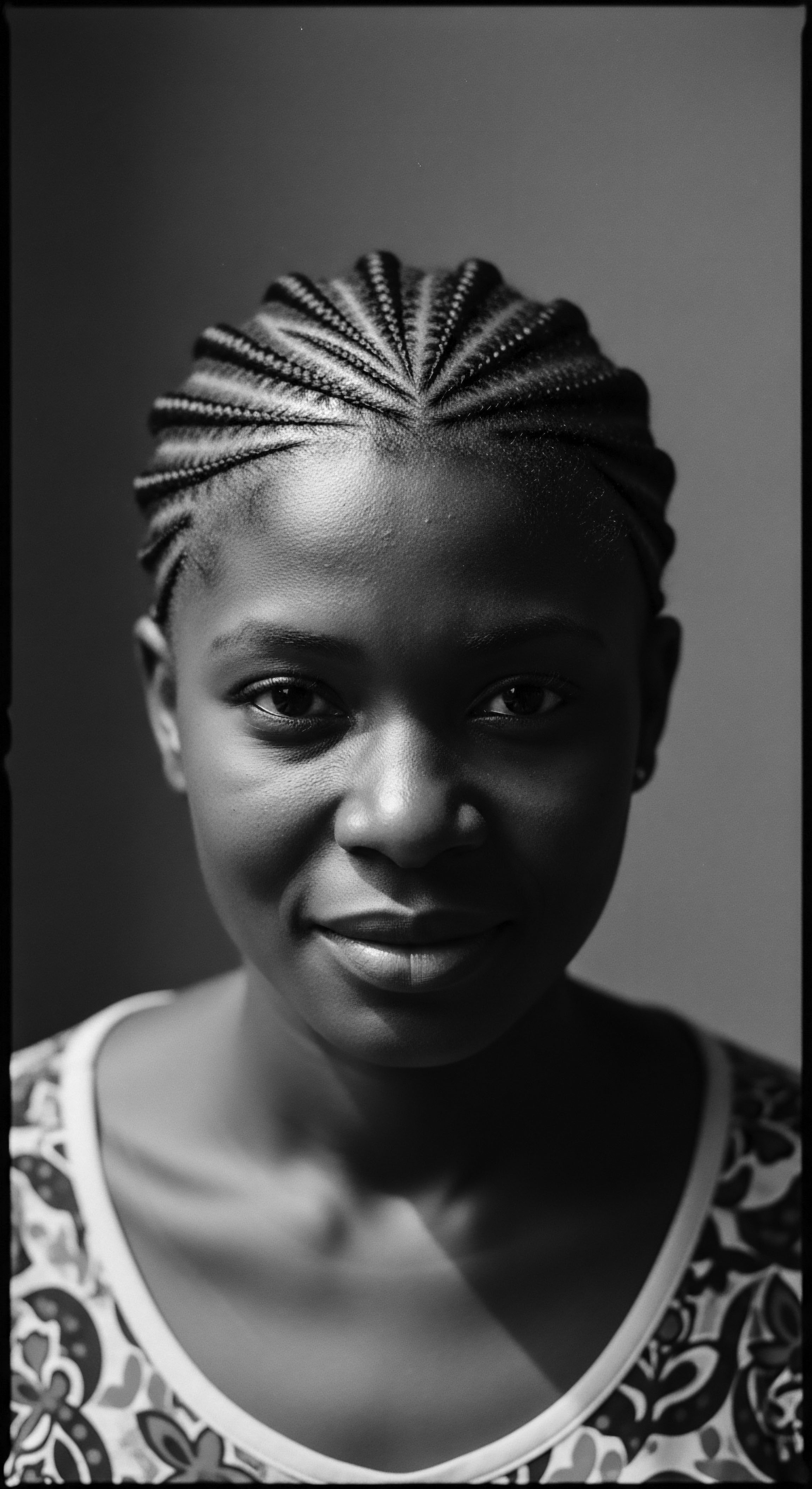
Relay
The legacy of cornrows extends far beyond their historical utility as tools of escape; they persist as dynamic expressions of modern Black identity, continually evolving while remaining profoundly rooted in ancestral acts of resistance. This continuity speaks to the enduring power of cultural practices to carry historical memory, shape contemporary consciousness, and serve as a canvas for ongoing struggles for recognition and liberation. The symbolic weight of cornrows today is substantial, encompassing not only historical defiance but also declarations of beauty, self-acceptance, and political assertion in a world still grappling with systemic racism and Eurocentric beauty norms. This is where the wisdom of the past meets the vibrant, complex tapestry of the present, where each meticulously created pattern becomes a public affirmation of a rich and resilient heritage.

What Declarations Do Modern Cornrows Make?
In the 20th century, particularly with the advent of the Civil Rights Movement and the Black Power movement, cornrows experienced a powerful resurgence as a symbol of Black pride and cultural identity. After decades where straightened hair was often seen as a necessity for societal acceptance, embracing natural styles, including cornrows, became a deliberate rejection of assimilation into mainstream, often white, beauty standards (BLAM UK CIC, 2022). This period marked a crucial shift; natural hair became a powerful visual statement of self-acceptance, a declaration of racial pride, and a silent protest against the historical denigration of Black features. Figures like Cicely Tyson, who famously wore cornrows on national television in the 1960s, made a groundbreaking statement, bringing Black hair heritage into mainstream view at a time when such visibility was profoundly radical.
The journey towards acceptance, however, has been far from linear. Despite their historical and cultural significance, cornrows and other traditional Black hairstyles continue to face discrimination in various social settings, from schools to workplaces (Beds SU, 2022). Policies often label these styles as “unprofessional” or “untidy,” forcing individuals to choose between their cultural expression and professional advancement. This ongoing struggle highlights that the act of wearing cornrows today remains, for many, a direct continuation of historical resistance against oppressive beauty standards and a demand for cultural equity.
The fight for hair freedom, as exemplified by the CROWN Act in the United States and the Halo Code in the UK, underscores the persistent need to protect the right of Black individuals to wear their hair as an authentic reflection of their identity and heritage without fear of discrimination. This struggle is not merely about hair; it is about bodily autonomy, cultural recognition, and the right to exist authentically within society.
Modern cornrows embody a powerful intersection of historical resistance and contemporary declarations of Black identity, beauty, and autonomy.
The connection between cornrows and resistance has evolved, yet its core remains steadfast. While ancestral cornrows might have literally mapped routes to physical freedom, contemporary cornrows chart a course toward psychological liberation and cultural affirmation. They stand as a visible rejection of societal pressures to conform, embodying the spirit of self-determination. They are a living testament to the survival of a culture that refused to be erased, a powerful reminder that heritage is not merely a relic of the past but a dynamic force shaping the present and future.

Cornrows as Artistic Medium and Cultural Preservation
Beyond their political and protective functions, cornrows are a profound artistic medium. The complexity of patterns, the precision of lines, and the ability to incorporate beads, shells, or threads transform the scalp into a dynamic canvas. This artistic expression, passed down through generations, preserves aesthetic traditions rooted in African craftsmanship.
Each unique design is a testament to creativity and skill, contributing to a diverse global hair culture. The artistry inherent in cornrows reinforces their value beyond mere utility, positioning them as a vital part of global aesthetic heritage.
- Pattern Storytelling ❉ Intricate designs can convey abstract narratives, personal histories, or even commemorate significant events.
- Adornment Symbolism ❉ The addition of beads or cowrie shells, traditional in many African societies, can carry meaning related to wealth, status, or spiritual protection.
- Visual Lineage ❉ Wearing cornrows connects the individual to a long line of ancestors who also adorned their hair in similar, culturally significant ways.

Intersections of Science and Heritage in Modern Cornrows
Modern hair science, while often developed in Eurocentric contexts, increasingly offers insights that validate the ancestral wisdom embedded in cornrow practices. The understanding of traction alopecia, for instance, underscores the importance of proper tension and regular maintenance—principles that skilled traditional braiders intuitively applied. The emphasis on moisturizing the scalp and hair, common in ancestral care regimens, aligns with modern scientific recommendations for maintaining scalp health and preventing dryness in textured hair, which can be prone to moisture loss due to its coil structure.
| Historical Role (Slavery Era) Covert Communication ❉ Literal maps for escape, signals for meeting times. |
| Modern Significance (Post Civil Rights) Overt Expression ❉ A visible statement of Black identity, cultural pride, and anti-assimilation. |
| Historical Role (Slavery Era) Survival Tool ❉ Concealing seeds and gold for sustenance during flight. |
| Modern Significance (Post Civil Rights) Cultural Continuity ❉ Preserving ancestral aesthetic and communal practices. |
| Historical Role (Slavery Era) Physical Protection ❉ Shielding hair from harsh elements and minimizing damage during labor. |
| Modern Significance (Post Civil Rights) Hair Health & Autonomy ❉ A protective style promoting growth and a challenge to discriminatory policies. |
| Historical Role (Slavery Era) The journey of cornrows mirrors the journey of Black identity itself—resilient, resourceful, and ever-asserting its inherent dignity. |
The science of hair porosity, for instance, helps us understand why textured hair often benefits from specific layering of products, a practice that mirrors traditional methods of sealing in moisture with natural butters and oils. This convergence of ancient practices and contemporary understanding solidifies the authority of traditional hair care as a truly effective and intelligent system. Cornrows, in this light, become a practical application of a profound historical and scientific knowledge, passed down through generations, ensuring the vitality of textured hair even in the face of ongoing challenges to its inherent beauty and cultural legitimacy.
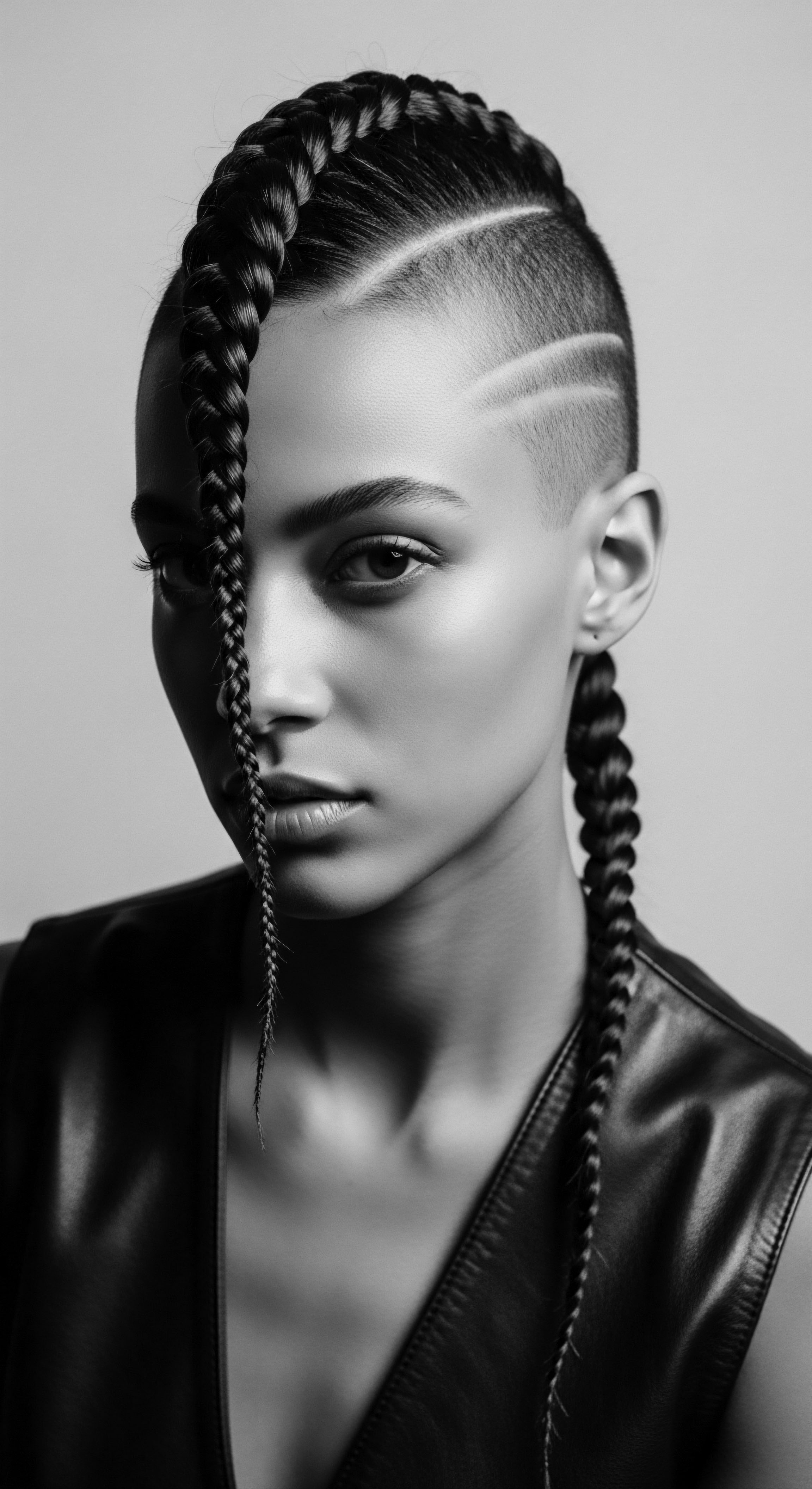
Reflection
The journey through the intricate world of cornrows reveals far more than a simple hairstyle; it unearths a profound meditation on the enduring power of textured hair as a repository of Black identity and a vehicle for historical resistance. From the meticulously plotted escape routes on the scalps of enslaved ancestors to the bold statements of self-acceptance in modern society, cornrows stand as a powerful symbol of continuous defiance. They represent a living, breathing archive of resilience, each braid a testament to the human spirit’s capacity to adapt, to communicate, and to survive in the face of overwhelming adversity.
Our hair, in its countless textures and forms, tells stories that transcend words. It whispers tales of ancestral wisdom, of clandestine communications, of quiet acts of rebellion that shaped destinies. The artistry and science embedded in cornrow creation, perfected over millennia, speak to an inherent understanding of the hair’s unique properties, a knowledge passed down through the gentle, knowing hands of mothers, aunts, and community elders. This collective memory, stored within the coils and patterns, forms a sacred heritage, reminding us that connection to our roots is a powerful, protective force.
In a world where societal pressures still seek to dictate standards of beauty, wearing cornrows today is a courageous affirmation of self. It is a reclaiming of narratives, a celebration of inherited beauty, and an ongoing act of resistance. The very existence of these styles on modern heads reinforces the profound legacy they carry—a legacy of strength, creativity, and an unyielding spirit. This tradition, rooted in communal care and ancestral wisdom, continues to shape Black identity, a vibrant helix twisting through time, always pointing towards freedom.

References
- Beds SU. (2022). Black History Month 2022 ❉ The History Behind Cornrows. Retrieved from https://www.beds.ac.uk/su/news/beds-su/2022/black-history-month-2022-the-history-behind-cornrows/
- BLAM UK CIC. (2022). The history of Black Hair. Retrieved from https://blamcharity.org/the-history-of-black-hair/
- Boakye, B. (2018). How cornrows were used as an escape map from slavery across South America. Retrieved from https://face2faceafrica.com/article/how-cornrows-were-used-as-an-escape-map-from-slavery-across-south-america
- Byrdie. (2022). The Beautiful, Black History of Cornrows. Retrieved from https://www.byrdie.com/history-of-cornrows-5197825
- Doria Adoukè. (2023). Unveiling the Rich History and Origins of Cornrows. Retrieved from https://doriaadouke.com/blogs/news/cornrows-history
- Human Material Loop. (2025). The Hidden Meaning Behind Cornrows. Retrieved from https://www.humanmaterialloop.com/post/the-hidden-meaning-behind-cornrows
- JALIZA. (2023). The Enduring Legacy of Cornrow Braids ❉ A Journey from Ancient Roots to Modern Expression. Retrieved from https://jaliza.com/blogs/news/cornrow-braids
- Odele Beauty. (2024). A History Lesson On Hair Braiding. Retrieved from https://odelebeauty.com/blogs/news/history-of-hair-braiding
- pan-African. (2021). A Celebration of Cornrows. Retrieved from https://pan-african.com/blogs/news/a-celebration-of-cornrows
- The Carolinian Newspaper. (2025). How Cornrows May Have Helped Free Slaves Navigate. Retrieved from https://www.thecarolinianonline.com/2024/02/26/how-cornrows-may-have-helped-free-slaves-navigate/
- The Queen’s Journal. (2025). History, identity, and community ❉ The significance of Black hair. Retrieved from https://www.queensjournal.ca/2024/02/history-identity-and-community-the-significance-of-black-hair/
- Travel Noire. (2021). How Braids Were Used By Enslaved People To Escape In South America. Retrieved from https://travelnoire.com/how-braids-were-used-by-enslaved-people-to-escape-in-south-america
